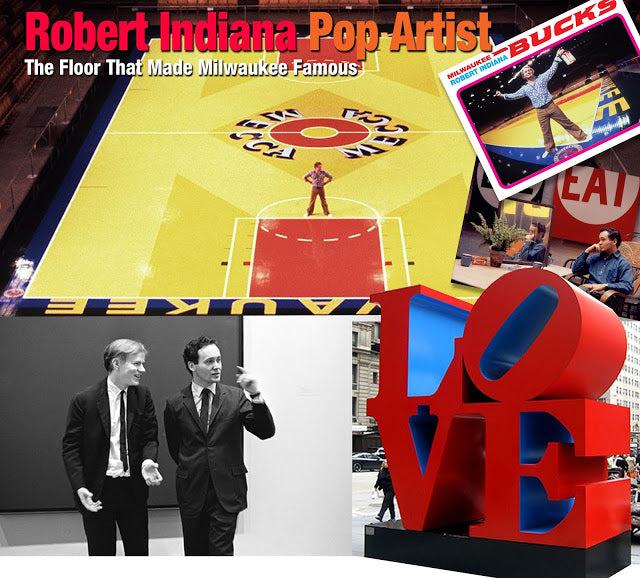
Robert Indiana: Pop Art Meets The Sports World
Having grown up in Milwaukee in the 1970s and 1980s, I took for granted that every city had a pro football, basketball, and baseball team, that every city had a Summer Fest (the world's largest music festival), and that every NBA/ABA team had a colorful basketball court. The court I refer to is Milwaukee's MECCA Arena, home to the Milwaukee Bucks, the Marquette Warriors, and for a short time in the late 70s the Milwaukee Does, a women's professional basketball team.
The basketball floor was quite a feather in Milwaukee's cap as city leadership culled pop artist Robert Indiana for the project. Indiana is most known for the very familiar LOVE design, which first appeared in a series of poems in 1958. It quickly found its way onto Christmas cards, postage stamps and also became a striking sculpture. RetroCards would like to honor his contribution to Milwaukee.
Mr. Indiana's passing on May 19, 2018 brought back many memories of the old MECCA floor which was no longer used once the Bucks moved into the Bradley Center in 1988. Thought lost, the floor showed up in an obscure auction and was purchased by a local fan. His efforts at saving the floor from the potential scrap heap was detailed in an excellent ESPN 30 For 30 short: MECCA: The Floor That Made Milwaukee Famous. It outlines the hiring of Robert Indiana, his process, city reaction at his hiring, and much more.
Highlights of the history of one of Robert Indiana's most unique designs:
• The Milwaukee arena floor needed painting and Chairman of Mecca Board Steve Marcus suggested using a world renown artist.
• Judith Posner (Milwaukee gallery owner) remembers, "They wanted to draw attention to Milwaukee and wanted to advertise the incredible arena."
• Marcus consulted with Posner who 'knew the perfect person': Robert Indiana. "He deals in large scale projects and his colors are bold."
• Barbara Brown Lee (Milwaukee Art Museum) adds, "Andy Warhol was known as the Pope of Pop Art, but I think Robert Indiana was the King."
• Judith Posner: "Steve Marcus and I decided to go to New York to talk to him (Indiana) about the project and he got real excited about it.
• Steve Marcus: "He (Indiana) had one proviso. The public couldn’t see it until the floor was finished."
• $27,500 was cost and the there were many a raised eyebrow in Milwaukee regarding the cost. Keeping the design secret when public money was involved became an issue. Also the fact that it wasn’t an local artist, was also looked down upon.
• The unveiling occurred on 10/04/77 when a huge tarp lifted to reveal the colorful design.
• It was the only basketball floor where paint covers the entire surface.
Star players remember:
Doc Rivers (Marquette player) – "[Marquette coach] Hank Raymonds wanted us to go over to the Mecca and practice to get used to the floor and I thought it meant 'to get used to the arena.' When you practiced there you realized that no, he meant 'used to the floor.' It was amazing how many times we got opposing players to step out of bounds or to stay in the 3-second lane. That court did that to you. It was a true home court advantage – I never knew it was an art piece. I thought I was playing on a confusing floor!
Sidney Moncrief (Milwaukee Bucks): “The players did discuss 'what happened to the floor? Are they going to bring the floor over? Are we going to have the Mecca court seal in the new Bradley Center?' But when we moved to the Bradley Center, we lost a huge home court advantage.”
Robert Indiana was pictured on the MECCA floor in Time Magazine and 265 different newspapers picked up the story. The people that thought it was money wasted suddenly realized all the free publicity the city was receiving. The Bucks enjoyed much success during those days and the floor became part of the Bucks image. While playing at the Mecca 1970-1988 the Bucks made the playoffs 18 times, went to 7 conference Finals, and won at least 50 games 12 times.
Check out ESPN's 30 for 30: 'MECCA: The Floor That Made Milwaukee Famous

